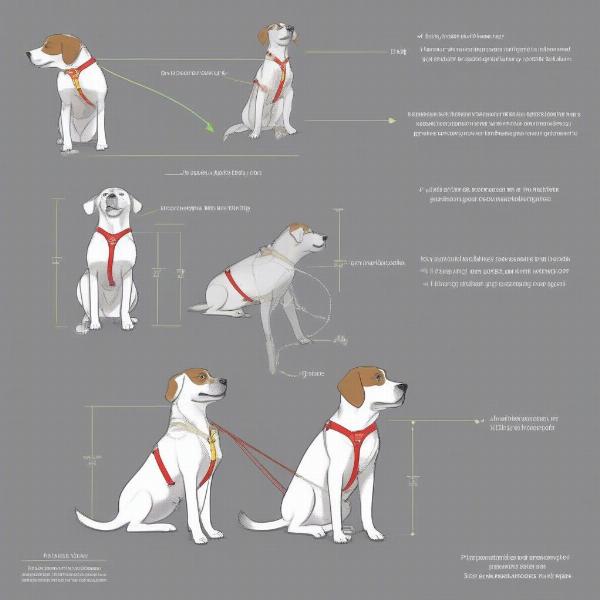Choosing the right harness can be a game-changer, especially if you have a Houdini-like dog. An escape-proof dog harness is crucial for safety and peace of mind during walks, training, or adventures. This guide helps you find the perfect fit for your furry friend, covering everything from harness types to fitting tips.
Understanding Escape-Proof Harnesses: Why They Matter
A regular harness can sometimes be a liability, allowing a clever dog to slip out and potentially into danger. Escape-proof harnesses, however, are designed with security in mind, featuring reinforced straps, strategically placed buckles, and a snug fit that prevents wriggling free. Whether your dog is a seasoned escape artist or you’re simply taking preventative measures, an escape-proof harness offers valuable peace of mind. Choosing the right harness depends on your dog’s breed, size, and temperament.
Types of Escape-Proof Harnesses
There are several types of escape-proof harnesses, each designed for different needs:
- Front-Clip Harnesses: These harnesses attach the leash to a ring on the dog’s chest. This design discourages pulling and redirects the dog’s attention back to the owner. They are a good choice for training and managing dogs who tend to lunge or pull.
- Back-Clip Harnesses: These offer a traditional attachment point on the dog’s back, providing comfortable control for relaxed walkers. Look for back-clip harnesses with extra secure fastenings and a snug fit for escape prevention.
- Dual-Clip Harnesses: Offering both front and back clips, these versatile harnesses provide options for training and walking. They’re excellent for transitioning a dog from a front-clip to a back-clip harness.
- Vest-Style Harnesses: These harnesses offer full-body coverage and multiple points of adjustment, making them an excellent choice for dogs who are particularly adept at escaping. The vest style distributes pressure evenly across the chest and back, providing comfort and security.
Choosing the Right Harness for Your Dog
Consider your dog’s size, breed, and escape tendencies when selecting a harness. For small dogs, a lightweight yet secure harness is essential. Larger, stronger breeds require robust harnesses with reinforced stitching and heavy-duty buckles.
 Measuring a dog for a harness
Measuring a dog for a harness
Finding the Perfect Fit: Measuring Your Dog
A properly fitted harness is key to preventing escapes. Follow these steps for accurate measurements:
- Chest Girth: Measure around the widest part of your dog’s chest, just behind the front legs.
- Neck Girth: Measure around the base of the dog’s neck where the collar usually sits.
- Length: Measure from the base of the neck to the base of the tail.
Refer to the manufacturer’s size chart and consider your dog’s build. Some harnesses are designed for specific breeds, like the siberian husky dog collars, so be sure to check for breed-specific recommendations.
Essential Features for Escape Prevention
Look for these features when shopping for an escape-proof harness:
- Multiple Adjustment Points: These allow you to customize the fit and create a snug, secure feel.
- Secure Buckles and Fasteners: Double-check buckles for durability and a secure locking mechanism.
- Reinforced Stitching: Strong stitching ensures the harness can withstand pulling and pressure.
- Durable Materials: Choose harnesses made from high-quality materials like nylon or ballistic nylon.
Introducing the Harness to Your Dog
Introduce the harness gradually to avoid startling your dog. Start by letting your dog sniff and investigate the harness. Reward calm behavior with treats and praise. Gradually fasten the harness, ensuring it’s snug but not too tight.
Conclusion: Secure Walks, Happy Adventures
Choosing the best escape-proof dog harness is an investment in your dog’s safety and your peace of mind. By understanding the different types of harnesses, measuring your dog correctly, and looking for key features, you can find the perfect fit for a secure and enjoyable walking experience. Remember to introduce the harness gradually and always prioritize your dog’s comfort. With the right harness, you can confidently embark on new adventures together.
FAQ:
- How do I know if a harness fits my dog correctly? You should be able to fit two fingers comfortably between the harness and your dog’s body.
- What is the best type of escape-proof harness for a puppy? An adjustable vest-style harness is often a good choice for puppies, allowing for growth.
- Can an escape-proof harness be used for training? Yes, especially front-clip and dual-clip harnesses.
- What materials are best for an escape-proof harness? Durable materials like nylon or ballistic nylon are recommended.
- How do I clean my dog’s harness? Check the manufacturer’s instructions, as cleaning methods vary depending on the material.
- Are there harnesses designed for specific breeds? Yes, some harnesses are tailored for specific breeds, like georgia bulldog dog collar or specific activities like pulling.
- What should I do if my dog still manages to escape from its harness? Check the fit and consider a more secure design, like a vest-style harness with reinforced buckles.
ILM Dog is your trusted source for expert dog care advice and product recommendations. We offer a comprehensive range of resources to help you navigate every aspect of dog ownership, from breed selection to senior dog care. We specialize in providing valuable information on dog health, training, nutrition, grooming, and much more, including products like the 2 hounds freedom no pull dog harness or alpine outfitters dog harness. For personalized guidance or to learn more about our services, contact us via email at [email protected] or by phone at +44 20-3965-8624. ILM Dog is committed to helping you provide the best possible care for your beloved companion.